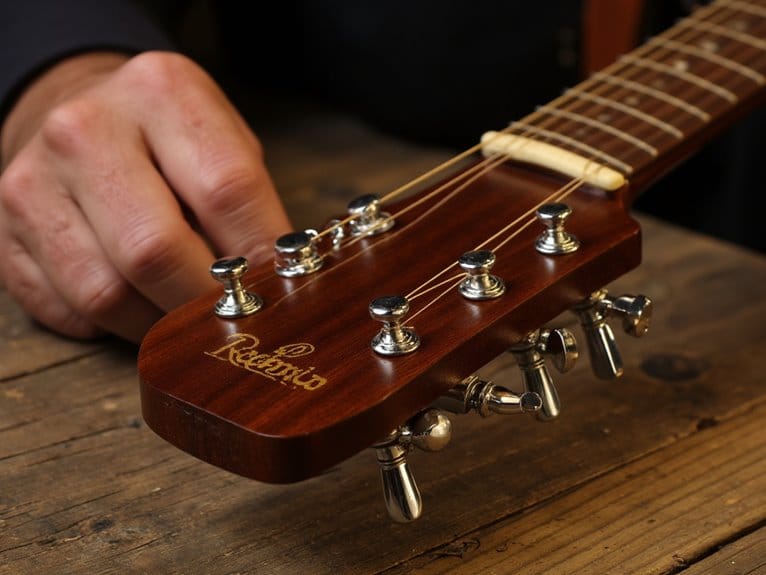What Was the First 7 String?
Andrei Sychra, a Russian guitarist, is credited with creating the first 7-string instrument in 1790, pioneering the concept of extended-range guitars that would later transform various musical genres. This innovation allowed for deeper bass notes and expanded tonal possibilities, paving the way for future guitarists to experiment with new sounds and techniques. As the 7-string's popularity grew, it attracted classical guitarists seeking to push the boundaries of their traditional repertoire. Its unique sonic capabilities have inspired generations of guitarists – and the fascinating story of its evolution is just beginning to unfold.
We are supported by our audience. When you purchase through links on our site, we may earn an affiliate commission, at no extra cost for you. Learn more.
Early Experimentation With Extra Strings
Experimenting with extra strings, guitarists have been pushing the boundaries of traditional instrumentation since the early 20th century, driven by a desire to expand their tonal palette and create new sounds. This tonal exploration led to the development of custom-made instruments, often featuring unconventional string configurations. The pursuit of string symmetry, where the additional strings mirrored the standard six-string layout, became a key aspect of this experimentation. Guitarists sought to create a sense of balance and harmony in their instruments, while also releasing fresh sonic possibilities. As a result, the 7-string guitar began to take shape, promising a new frontier of sound and technique for adventurous musicians.
Russian Roots of the 7-String
In the early 19th century, Russian guitarists, inspired by the nation's rich heritage of classical music and folklore, began to craft their own 7-string instruments, laying the groundwork for a unique sonic identity that would later influence the global guitar community.
Russian luthiers experimented with various configurations, creating a distinctive sound that resonated with Soviet folk traditions. Some notable features of these early 7-strings include:
- Extended range and tonal palette
- Use of steel strings for added brightness
- Innovative neck and body designs
- Experimentation with different tunings
- Blending of classical and folk playing styles
This pioneering work by Russian luthiers and musicians paved the way for future generations of guitarists to delve into the possibilities of the 7-string instrument.
The Classical Guitar Connection
The 7-string's inherent versatility and expanded tonal range made it an attractive instrument for classical guitarists seeking to push the boundaries of their traditional repertoire. The added string enabled classical guitarists to delve into new textures and timbres, injecting fresh life into the genre. As a result, the 7-string became an ideal vehicle for classical nuances, allowing guitarists to tackle complex, intricate compositions with greater ease. The instrument's extended range also opened up new possibilities for arranging and transcribing existing guitar repertoire, breathing new life into beloved classical pieces. With its unique sonic capabilities, the 7-string has become an indispensable tool for classical guitarists seeking to innovate and expand the genre's boundaries.
Ibanez Enters the Scene
Riding the wave of 7-string enthusiasm, Japanese manufacturer Ibanez responded to the growing demand for extended-range instruments with a series of innovative designs that would forever change the electric guitar landscape. Ibanez's origins date back to the 1950s, when Japanese entrepreneur Hoshino Gakki began importing and distributing guitars from the US. However, it wasn't until the 1980s that Ibanez started to make a name for itself as a pioneering force in electric guitar design.
Some key features that contributed to Ibanez's success include:
- Thin, fast necks that facilitated virtuosic playing
- High-gain pickups designed to handle low tunings
- Innovative body shapes that maximized playability and comfort
- Affordable pricing that made 7-strings accessible to the masses
- Asian influence that brought a unique aesthetic and design sensibility to the table
Steve Vai's 7-String Revolution
As the 7-string guitar's popularity began to simmer, virtuosic guitarist Steve Vai seized the opportunity to propel this fledgling instrument into the mainstream, triggering a sonic upheaval that would forever alter the electric guitar's harmonic landscape. Vai's Influence extended far beyond his own music, inspiring a generation of guitarists to delve into the possibilities of the 7-string. His groundbreaking work on 'Passion and Warfare' (1990) showcased the instrument's capabilities, transporting listeners to Seven Heaven with its lush, sweeping arpeggios and soaring melodies. Vai's innovative approach not only legitimized the 7-string but also paved the way for its widespread adoption in progressive rock, metal, and beyond. His impact on the electric guitar's evolution is undeniable, cementing his status as a true visionary.
The Rise of Nu Metal
Nu metal's sonic storm surge, fueled by downtuned, chunky riffs and angst-ridden vocals, was about to crash onto the mainstream scene, forever changing the musical landscape. This new wave of heavy music was characterized by:
- Heavy riffs and aggressive tones that ripped through the air
- Tunings that plummeted to the depths of drop-D and beyond
- Vocals that screamed, growled, and wailed in anguish
- Rhythms that pounded like a sledgehammer to the chest
- Guitarists who dared to experiment with unorthodox techniques and tunings
As nu metal rose to prominence, 7-string guitars became the weapon of choice for these sonic warriors, allowing them to tap into the darker, heavier corners of the musical spectrum. The results were brutal, beautiful, and utterly mesmerizing.
7-String Adoption in Jazz
The jazz world, notorious for its harmonic complexity and improvisational virtuosity, found an unlikely ally in the 7-string guitar, which allowed musicians to weave intricate tapestries of sound and venture into uncharted territories of tonal depth. The additional string enabled jazzers to discover novel voicings and textures, effortlessly traversing the complex jazz harmonies that often feature extended chords. With the 7-string, guitarists could craft rich, layered soundscapes, deftly incorporating altered dominants, minor 11th chords, and other harmonic curiosities. This newfound sonic flexibility inspired a new wave of jazz innovators, who utilized the 7-string's capabilities to push the genre's boundaries even further. As a result, the 7-string became an indispensable tool in the jazz guitarist's arsenal, revealing fresh avenues of creative expression.
Modern 7-String Innovations
How have modern guitarists capitalized on the 7-string's potential, leveraging its extended range to forge unprecedented sonic landscapes and reinvent the boundaries of jazz improvisation? They've pushed the envelope with advanced tunings, exploring fresh harmonic territories and textures. Here are some examples:
- Tapping into microtonal explorations, players like Tosin Abasi and Animals as Leaders' Javier Reyes have crafted intricate, otherworldly soundscapes.
- The use of open tunings has allowed for droning, ambient textures, as seen in the work of Russian Circles' Mike Sullivan.
- Extended-range chords have enabled guitarists to create complex, jazz-inspired harmonies.
- Advanced legato techniques have enabled seamless, fluid playing.
- Experimentation with altered tunings has led to the creation of unique, genre-bending sounds.
These innovations have not only expanded the 7-string's sonic palette but have also redefined the role of the guitar in modern jazz and beyond.
Legacy of the 7-String Guitar
Seven decades of innovation have cemented the 7-string guitar's status as a versatile, genre-defying instrument, leaving an indelible mark on the sonic landscape of jazz, metal, and beyond. Its impact is evident in the iconic riffs and solos of famous players like Steve Vai, John Petrucci, and Korn's Munky, who have all exploited the 7-string's expanded tonal palette. Alternative tunings, such as dropped-A and open-G, have also been popularized by 7-string enthusiasts, revealing new sonic possibilities. From the jazz virtuosity of George Van Eps to the djent-inspired polyrhythms of modern metal, the 7-string guitar has become an indispensable tool for musicians seeking to push the boundaries of their craft. Its legacy continues to inspire and challenge guitarists, ensuring its relevance in the perpetually changing world of music.






